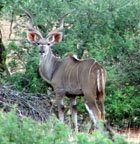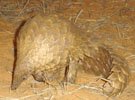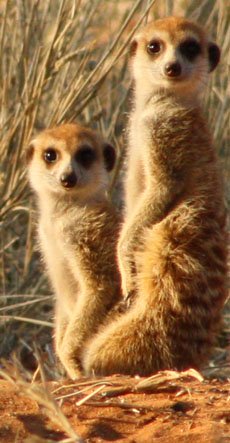For more information about our hunting safaris, don’t hesitate to reach out and contact us!
Video: Hyenas vs Lions!
Hyenas and lions are enemies from a very long time ago. As you will see in this video, they often try to take off one another's food. It is also common for them to kill each other's offspring!
Watch this video:
Did You Know?
Although hyenas bear some physical resemblance to wild dogs, they make up a separate biological family which is most closely related to Herpestidae (the family of mongooses and meerkats).
The hyena has one of the strongest jaws in the animal kingdom and an adult of the species has only the large cats of the family Felidae (Lions, Tigers, etc.) to fear.
An adult hyena's bite pressure can reach 800 lb per square inch... it can crush bone!
More Interesting Facts...
Like dogs, but unlike other animals in the same habitat, hyenas do not kill their prey directly. Having chased their prey to exhaustion, their prey is unable to mount any further defence of itself, and is captured and eaten while still alive. Although somewhat distasteful from the human perspective, the speedy disembowelment of the prey means that death often comes sooner than with the methods employed by other predators (for example, suffocation) and is an efficient means of eating which lessens the probability of the kill being lost to another predator.
Hyenas often form clans and these clans have many confrontations with lions. When defending territories and dens, the behavior is similar to when the clan is attacked by other hyenas. There is increased attention on the cubs, though, since lions often pay visits to hyena territory to kill their offspring.
Again, the hyenas huddle together to form a wall. It is naturally easier for the lions to break this wall, because of their bulk, but the hyenas quickly form it again as soon as they are spread. If the hyenas are too few, they will not attack the lions, but stay in defense, trying to tire the big cats out.
Intelligent Creatures
Hyenas are highly intelligent predators, and some scientists claim they are of equal intelligence to certain apes.
One indication of hyena intelligence is that they will move their kills closer to each other to protect them from scavengers; another indication is their strategic hunting methods.
If the hyenas are numerous enough, however, they lunge forward and aim for the lions' hindquarters and try to rip their haunches and bite their tails off. Since lions have both teeth and claws to fight with, hyenas are more likely to attack from the behind and drag the lion down on the ground, where they attempt to tear the soft belly apart.
If it is the hyenas that are the attackers and are out to kill the lions' offspring, they come in large numbers, distracting most of the adult lions while a couple of quick hyenas snatch the cubs. At least four hyenas are needed to chase off a lioness, while at least six hyenas are required to even up a confrontation with an adult male lion. Again, biting and tearing from behind is preferred rather than facing the big cats' deadly claws.
Similar behavior is seen when stealing a kill, which hyenas are quite successful at. When defending a kill, the hyenas can be the losers when lions are involved, since they don't hunt in extremely large groups but rather prefer to kill several times the same night.
The lions often come in large raiding parties to make sure they can steal the hyenas' prey. However, hyenas have learned to deal with this and usually they are fortunate enough to call more of the clan together and take their prey back, unless an adult male lion is present, as male lions seem to truly terrify hyenas and hyenas rarely challenge them.
Stealing kills from cheetahs and leopards and other loners, on the other hand, rarely requires fighting and calling the clan. It can get a bit dramatic when a hyena clan faces a pack of African wild dogs, but not nearly as violent as encounters with lions. Usually, it is the wild dogs that back out. In spite of being fierce killers, wild dogs are more docile than the aggressive hyenas.
Meaning of "Uitspan"
'Uitspan' is an Afrikaans word that means place of rest.
When the Boer settlers moved inland in Southern Africa in the 1800's, they used ox carts. When they found a spot with game, water and green grass, they arranged their ox carts into a circular laager for protection against wild animals and stopped for a rest.
They referred to such an action of relaxation for man and beast, as Uitspan.

(Picture above of our ancestors.)
Did you know? Greater Southern Kudus are famous for their ability to jump high fences. A 2 m (6.56 ft) fence is easily jumped while a 3 m (9.84 ft) high fence is jumped spontaneously. These strong jumpers are known to jump up to 3.5 m (11.48 ft) under stress. |
Did you know? Some animals have one sense more than man!The flehmen response is a particular type of curling of the upper lip in ungulates, felids and many other mammals. This action facilitates the transfer of pheromones and other scents into the vomeronasal organ, also called the Jacobson's Organ. Some animals have one sense more than man!The flehmen response is a particular type of curling of the upper lip in ungulates, felids and many other mammals. This action facilitates the transfer of pheromones and other scents into the vomeronasal organ, also called the Jacobson's Organ.This behavior allows animals to detect scents (for example from urine) of other members of their species or clues to the presence of prey. Flehming allows the animals to determine several factors, including the presence or absence of estrus, the physiological state of the animal, and how long ago the animal passed by. This particular response is recognizable in males when smelling the urine of a females in heat. |


